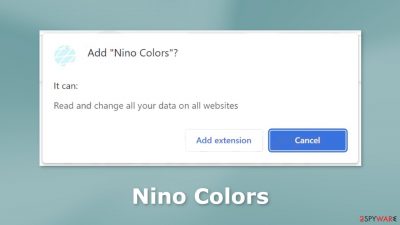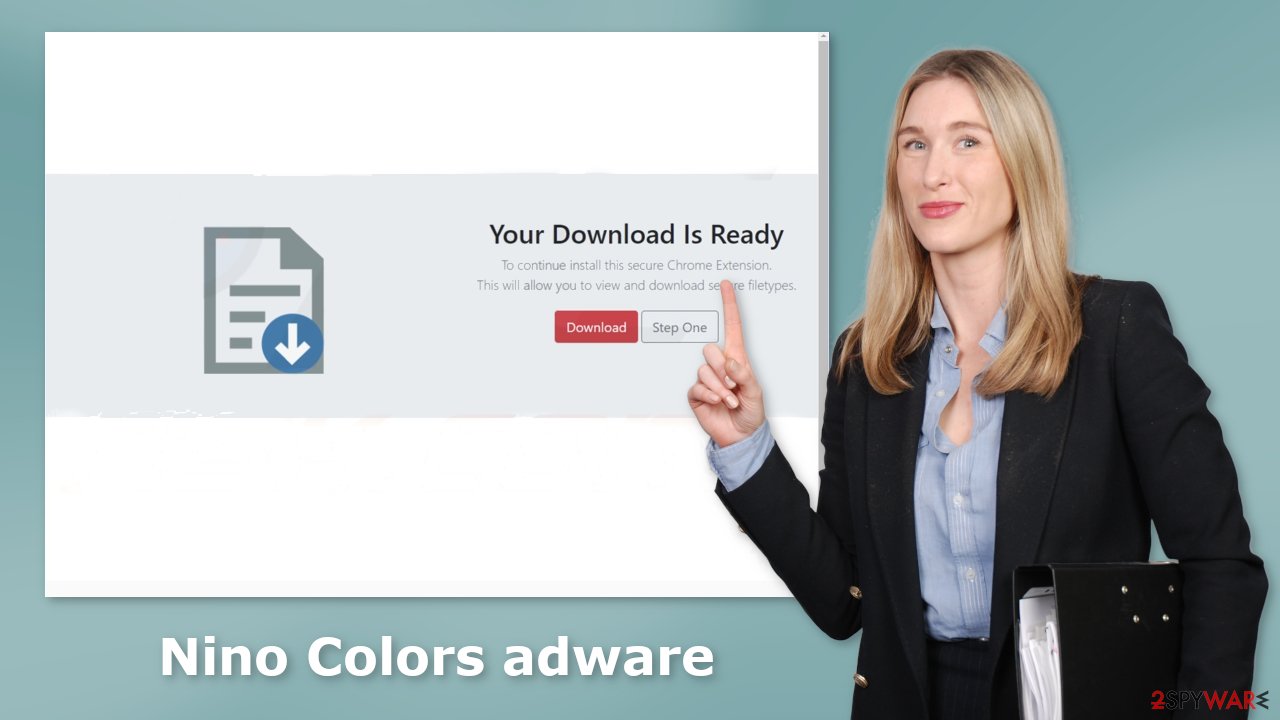Nino Colors adware (spam) - Free Guide
Nino Colors adware Removal Guide
What is Nino Colors adware?
Nino Colors adware uses spam and cookies to generate revenue for crooks

Nino Colors is a rogue browser extension that is promoted as a useful tool that helps change website colors. However, it has adware[1] capabilities. It can cause an increased amount of commercial content, like pop-ups, banners, and redirects. Crooks use such applications to generate revenue.
The promised functions of changing website colors are questionable. Often, such applications do not even provide the advertised benefits and just is a way for crooks to generate passive income. It is never good to have useless third-party applications on your computer.
Unfortunately, the extension could be using rogue advertising networks that place ads leading to dangerous websites. People can end up on scam pages, sites that try to trick them into providing personal information, downloading PUPs (potentially unwanted programs),[2] and even malware.
| NAME | Nino Colors |
| TYPE | Adware |
| SYMPTOMS | Annoying pop-ups and other types of advertisements start appearing on the screen |
| DISTRIBUTION | Shady websites, deceptive ads, freeware installations |
| DANGERS | Links embedded in the ads might lead to dangerous websites |
| ELIMINATION | Eliminate the extension through your browser settings; scanning the machine with anti-malware tools is recommended |
| FURTHER STEPS | Use FortectIntego to get rid of any remaining damage and to optimize the machine |
Distribution methods
Crooks often try to make their applications look like “handy” tools so it is important to do your research. We always recommend using official app stores. Apps that get listed there, have to go through an extensive review process. However, you should still read the reviews, look at the ratings, and the number of users.
Sometimes, crooks also create “official” promotional websites for their apps. They try to make them look as good as possible so people would download them themselves. You should remember that if it is too good to be true – it probably is. It is also important to apply safe browsing practices.
Do not browse through shady pages, and do not click on random links and ads even if they seem to be promoting legitimate products and services. Unregulated websites can be full of deceptive ads and sneaky redirects, so it is best to stay on pages that you know and trust.

Freeware installations
Often people start experiencing unwanted symptoms after using freeware distribution platforms. It is possible that Nino Colors adware appeared on your device without your knowledge. Unsafe download channels include additional programs in the installers to make their activity profitable.
Often bundled software does not benefit users. It is important to pay attention during the installation process. Always choose the “Custom” or “Advanced” installation methods, read the Privacy Policy and Terms of Use. The most important step is to check the file list and untick the boxes next to any unrelated applications.
Remove Nino Colors adware
Nino Colors adware can be removed by going to the browser settings and looking at the extension list. We recommend removing plugins one by one to see if you notice any changes.
How to prevent from getting adware
Access your website securely from any location
When you work on the domain, site, blog, or different project that requires constant management, content creation, or coding, you may need to connect to the server and content management service more often. The best solution for creating a tighter network could be a dedicated/fixed IP address.
If you make your IP address static and set to your device, you can connect to the CMS from any location and do not create any additional issues for the server or network manager that needs to monitor connections and activities. VPN software providers like Private Internet Access can help you with such settings and offer the option to control the online reputation and manage projects easily from any part of the world.
Recover files after data-affecting malware attacks
While much of the data can be accidentally deleted due to various reasons, malware is one of the main culprits that can cause loss of pictures, documents, videos, and other important files. More serious malware infections lead to significant data loss when your documents, system files, and images get encrypted. In particular, ransomware is is a type of malware that focuses on such functions, so your files become useless without an ability to access them.
Even though there is little to no possibility to recover after file-locking threats, some applications have features for data recovery in the system. In some cases, Data Recovery Pro can also help to recover at least some portion of your data after data-locking virus infection or general cyber infection.
- ^ Adware. Malwarebytes. Cybersecurity Basics.
- ^ Potentially unwanted program. Wikipedia, the free encyclopedia.
- ^ Dusan Vasic. What Are Cookies? The Good and the Bad of Browser Cookies. Dataprot. Security Solutions.










